二语习得课件
- 格式:doc
- 大小:104.00 KB
- 文档页数:11



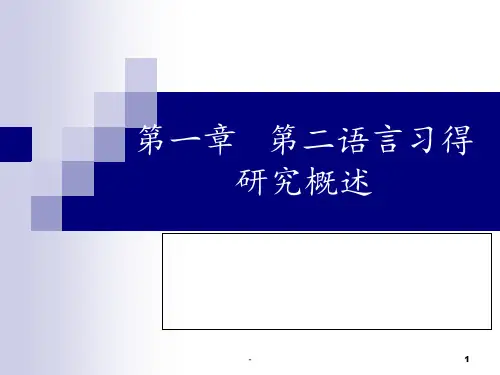
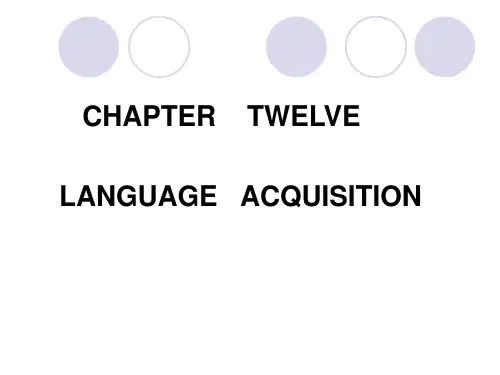

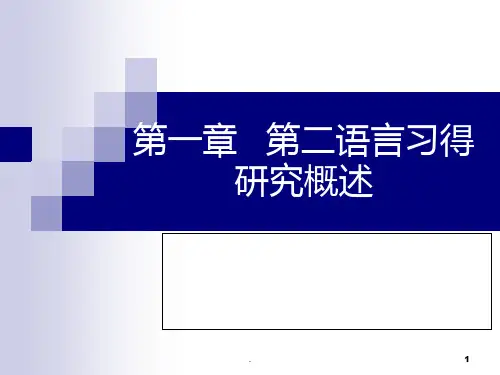
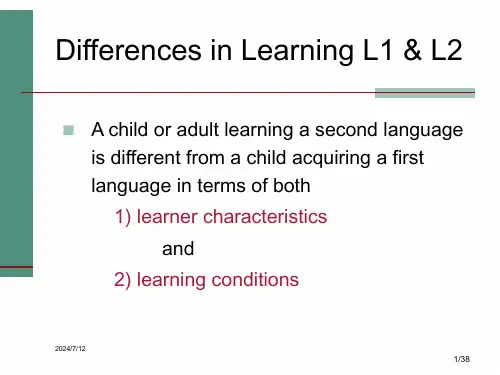
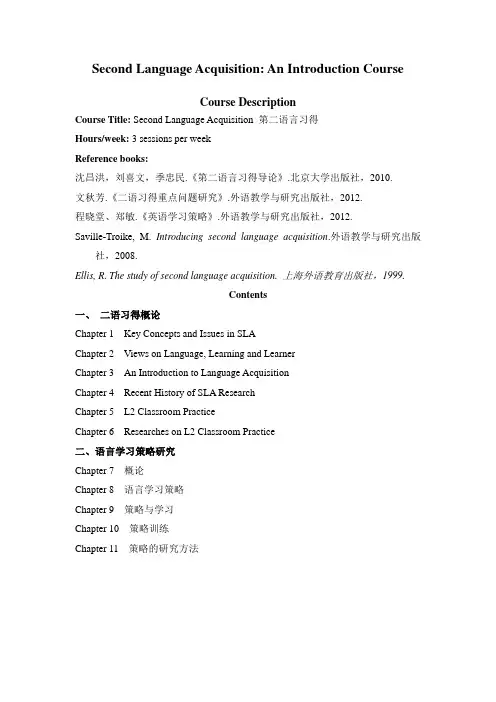
Second Language Acquisition: An Introduction CourseCourse DescriptionCourse Title: Second Language Acquisition 第二语言习得Hours/week: 3 sessions per weekReference books:沈昌洪,刘喜文,季忠民.《第二语言习得导论》.北京大学出版社,2010.文秋芳.《二语习得重点问题研究》.外语教学与研究出版社,2012.程晓堂、郑敏.《英语学习策略》.外语教学与研究出版社,2012.Saville-Troike, M. Introducing second language acquisition.外语教学与研究出版社,2008.Ellis, R. The study of second language acquisition. 上海外语教育出版社,1999.Contents一、二语习得概论Chapter 1 Key Concepts and Issues in SLAChapter 2 Views on Language, Learning and LearnerChapter 3 An Introduction to Language AcquisitionChapter 4 Recent History of SLA ResearchChapter 5 L2 Classroom PracticeChapter 6 Researches on L2 Classroom Practice二、语言学习策略研究Chapter 7 概论Chapter 8 语言学习策略Chapter 9 策略与学习Chapter 10 策略训练Chapter 11 策略的研究方法Chapter 1 Key Concepts and Issues in SLA1.1 Language Acquisition and SLAThe acquisition of language “is doubtless the greatest intellectual feat any one of us is ever required to perform.”--- Bloomfield, 1933A very young child began acquiring at least one language –what linguistists called as her First Language (L1) – mostly with very little conscious effort or awareness. L1 acquisition is a complicated but relatively rapid process through which a child grows up as a competent and proficient user of her native language(s). Every aspect of language acquisition is extremely complex. Yet young children – before the age of five – already know most of the intricate system which people have been naturally describing as the grammar of a language. Before they can add 2 plus 2, children are conjoining sentences, asking questions, using appropriate pronouns, negating sentences, forming relative clauses, and using the syntactic, phonological, morphological, and semantic rules of the grammar.Second language acquisition stands in contrast to first language acquisition. It is the study of how learners learn an additional language after they have acquired their mother tongue. The process of learning a non-native language is far more difficult, time-consuming, and much less likely to end in a state of complete mastery exactly fluency.SLA research has tended to follow in the footsteps of L1 acquisition research, both in its methodology and in many of the issues that it has treated. It is not surprising that a key issue has been the extent to which SLA and L1 acquisition are similar or different processes.1.2 A Theoretical Approach Proposed by SpolskyAn example of a particular theory or “model” of L2A from Spolsky is shown below:A “model” of L2A adapted from Spolsky (1989:28)This model depicts a “general theory of second language learning.” It depicts the researcher‟s theoretical views on the overall relationship between contextual factors, learner differences of individuals, learning opportunities and learning outcomes. The rectangular boxes show the factors that are most significant for learning. Any variation can lead to differences in success or failure. The arrows connecting the various boxes show the directions of influences. The contents of the various boxes are defined at great length, as consisting of clusters of interacting “Conditions”, making language learning successful.1.3 Some Distinctions in the field of SLA Research1.3.1 SLA and FLASLA is the study of L2A. According to the traditional definition, L2A typically takes place in a setting in which the language to be learned by a nonnative speaker is the language spoken in the local community. Therefore, a Chinese native learning English in England is generally defined as a L2 learner. In some definition L2A needs to take place in either an instructed setting or a non-instructed one.Foreign Language Acquisition (FLA) take place in a setting in which the language to be learned is not the one used in the local community. So the learning of English at schools in China would be an example of FLA. In most cases, FLA takes place in a setting with formal language instruction.Generally, the term SLA here is employed for referring to the study on both L2A and FLA because it is assumed that the underlying process is essentially similar.1.3.2 Acquisition versus LearningThe second tricky but also controversial distinction is the one between Acquisition and Learning. Krashen and Terrell (1983) define “acquisition”as the product of a “subconscious”process, similar to that of children in learning their L1, and learning as the product of formal teaching, which results in conscious knowledge about the language, but the distinction cannot be as simple as that.Krashen claimed that learning the rules could not lead to an automatic use of language as in acquisition. Probably, Krashen used the term “subconscious”in a non-technical sense, as the inability to explain what one knows. In other words, learners may use language forms correctly without being able to explain the forms.Accordingly, acquisition is seen as a natural process of growth of knowledge and skill in a language without a level of meta-knowledge about the language, while learning is seen as an artificial process in which the “rules” of a language are learned. There are indeed two differentmental process involved in acquisition and learning, but this does not mean that acquisition and learning cannot interact. Though not all learning necessarily leads to acquisition, learning could be the carrying out of activities that enhance the growth of knowledge.1.3.3 Input versus IntakeRelated to the notion of “consciousness” is the third distinction between Input and Intake. Input is everything around us we may perceive with our senses, and Intake (or Uptake) is what we pay attention to and notice.Some level of attention is required to be able to notice something, and that noticing is crucial for taking in new information. There is a lot of information in our environment, but what and how we make use of all that information depends on our needs and interests. (Most people may not be interested in the noise from the running machines, but for those who study on noise pollution it may get to be a very relevant piece of information. And at that point, they will notice. The same is true for language learning.) There is little doubt that input is the main source of information for learning, but not all input leads to intake, which is necessary for teaching. It is not easy to know under what condition input is actually helpful for learning. From experiments in consciousness, experts do know that unexpected events often arouse some attention.In addition, expectations are important for one‟s perceptibility and noticeability so it is clear that teaching may have an awareness-raising effect, increasing the noticing of features in input through the establishment of expectation and comprehension.For intake, at least some minimal level of mental processing needs to take place. There must be some awareness of new information relevant for the learning system to incorporate. Intake may refer to information that strengthens existing knowledge, or it may fill a gap in knowledge that was noticed by the learner before.1.3.4 Implicit versus Explicit LearningSchmidt (1990) points out that implicit learning is acquisition of knowledge about the underlying structure by a process that takes place naturally, simply and without conscious operations. Explicit learning is a more conscious operation where a learner makes and tests hypotheses in a search for structure.According to Schmidt, there is evidence that giving learners explicit rules helped in an experimental study, and the results of larger scale studies also slightly favor an explicit focus on grammar. But there is not much evidence on which to base an evaluation of the implicit rule acquisition in L2 learning. The implicit learning issue is the most difficult to resolve. On the one hand, there is evidence for it, but there is also evidence that conscious understanding helps in the process of L2A.Chapter 2 Views on Language, Learning and Learner2.1 Views on the Nature of LanguageAny human being is to acquire a language in the first few years of life. The knowledge acquired is largely of an unconscious sort. A school child could utter a fully formed sentence, which includes a relative clause (“I want that toy that that boy is playing with.”), not knowing how to state out the function of relative clauses and how to easily divide this sentence into its component parts.The complex knowledge humans have about their native languages is largely unconscious. There are several aspects of language to be described systematically.2.1.1 Phonetics and PhonologyThe sound system (phonology) of all languages is complex. Minimally, it entails knowing what possible sounds are and what are not for its native speakers.If a particular sound is studied on, it gets to the area of phonetics which describes the articulation of individual sounds. A native speaker of English can tell that the sound [x] in [Xi Hu] (the West Lake) is not a sound in English. The similar example can be the English consonants of [θ] & [ð] to speakers of other languages.Phonological knowledge also involves knowing what happens to words in fast speech as opposed to more carefully articulated speech. Consider the following dialogue between A (a nonnative speak) and B (a native speaker):A: What are you going to do?B: I’m gonna wriDa leDer.A: What? I can’t hear you.B: I’m going to write a letter (articulated slowly and clearly).Native speakers of a language know when to combine sounds in “normal, fast” speech and when not to in slower and clearer speech. They know not only possible sounds, but also know what are possible combinations of sounds and what sounds are found in what parts of words. In English, while [b] and [n] are both sounds of English, they cannot form a “blend” in the way that [b] and [r] can: *bnick versus brain. The sound [ŋ], which is frequent in English, however, cannot appear in the beginning of words in English, although it can in other languages.2.1.2 SyntaxThe syntax of a language is frequently known as its grammar, referring primarily to the knowledge of word order in a sentence. There are two kinds of grammar, generally referring to Prescriptive Grammar and Descriptive Grammar.Here are some prescriptive rules of English grammar as1) never end a sentence with a preposition;2) never split infinitives;3) never begin a sentence with a conjunction;4) never use contractions in writing;5) use between only with two items and among only with more than two.It is about such rules generally taught in school, often ignoring the actual use of the language.Modern linguists are concerned with descriptive grammars: the language as they are actually used. Thus, the knowledge of syntax just refers to descriptive grammar because native speakers of English frequently violate the prescriptive rules. As with phonological knowledge, native speakers of a language know which possible sentences of their language are.a. sentence ordere.g. The big book is on the brown table. (*The book big brown table the on is.)b. sentences with equivalent meaninge.g. Tom was hit by a car. (= A car hit Tom.)Yesterday Sally saw Jane. (Sally saw Jane yesterday.)Thus, knowing a language entails knowing a set of rules with which we can produce an infinite set of sentences.e.g. The woman wearing the green scarf ran across the street to see the gorilla that had justescaped from the zoo. (Even though such event is quite rare, people can understandwhat it really means.)2.1.3 MorphologyMorphology is the study of word formation. For example, the word reusable is made up of three parts: 1) re-, a prefix; 2) use, a verb; 3) –able, a suffix. Each part is referred to as a morpheme defined as the minimal unit of meaning. There are two classes of morphemes: bound and free. The former is one that can never be a word by itself; a free morpheme is one that is a word in and of itself.2.1.4 SemanticsSemantics refers to the study of meaning. It does not necessarily correspond to grammaticality because many ungrammatical sentences are meaningful as the following sentencese.g. *That woman beautiful is my mother.*I‟ll happy if I can get your paper.These sentences by nonnative speakers of English are comprehensible, though not following the “rules” of English. The opposite is the sentence that is grammatically formed but, because of the content, is meaningless (at least without additional contextualization), as in “*That bachelor ismarried.”Semantics entails knowledge of the reference of words. E.g. The English word table refers to an object with a flat top and either three or four legs.2.1.5 PragmaticsAnother area of language as what L2 learners need to learn has to do with pragmatics, or the use of language in context. For example, when we answer the telephone and someone says “Is John there?” We know that this is a request to speak with John. It would be strange to respond “Yes.” With the caller saying “Thank you.” and then hanging up. Clearly, the phrase “Is X there?”in this context is a request to speak with someone and not an information question. Similarly, the word order within a sentence may have an effect on meaning in some grammatical contexts.e.g. The man bit the dog. / The dog bit the man.2.2 Views of the Language Learning Process – L1versus L2The acquisition pattern is familiar: cries evolve to babbles, babbles are shaped into words, and words are joined to create sentences. This sequence describes the path taken by all children as the language they hear around them is taken in, internalized, and eventually developed into native-speaker competence.Experts try to understand how a child learns one language in a relatively simple cognitive and social environment, so that they have a basis for describing and interpreting a child‟s experience with multiple languages in complex social circumstances. The study of language acquisition began by carefully observing young children‟s learning to talk. Before there was a single hypothesis probing the nature of this process, researchers were recording the speech of their children and creating a database.In spite of agreement among researchers that the data are essential for theory building, reliable observations based on large numbers of children have been quite difficult. The studies tend, by necessity, to be small-scale, inferential, and complicated. But even the case study of a single child, presents a difficult task to the researcher. Documenting children‟s utterances in the compilation of a language diary requires great efforts, but those who have persisted have gained a wealth of insights.The challenge of empirical studies is to create indirect means of questioning, since researchers could not ask children directly to comment upon their linguistic reflections. Researchers could access children‟s language only through the filter of their cognition, and the two may not be equally developed.2.2.1 Children’s Acquisition of LexiconChildren‟s vocabulary acquisition needs to be described in three aspects of development: itsrate and pattern, the way words are used (or even misused), and the relation between lexicon and the child‟s cognitive development. The normative study in 1995 reported that by sixteen months of age children could reliably understand a mean of 191 words and produce a mean of 64 words. After that point, there is the legendary production speed: by thirty months of age, the mean number of words in productive vocabulary is 534.This period of rapid vocabulary growth during the second year of life has been called the “vocabulary burst”. However, even allowing for individual variation within the pattern, the rate of vocabulary growth throughout childhood is quite astonishing. Anglin in 1993 placed this progress at about 5 words per day during the school years; Clark in 1995 estimated the rate to be 10 words per day until the age of six and only slightly fewer through to the age of seventeen; in the boldest proposal of all, Pinker in 1995 declared that children learn one word every two waking hours from about eighteen months old through adolescence.A second salient aspect of children‟s early vocabulary is that early words are not always used correctly. Children make consistent, classifiable errors in their efforts to use their fledgling vocabularies. Children typically commit four types of errors while using words: overextension, underextension, overlap, and mismatch, but the greatest research attention has focused on overextension. The concepts to which words had been overextended usually shared some perceptual or functional feature with the actual meaning of the word, and children were attempting to label an unknown concept with a known word on the basis of analogy.2.2.2 Children’s Acquisition of SyntaxFrom the time children begin combining words to create compositional utterances, an achievement that begins to reveal itself at about eighteen months of age, there is an unmistakable respect for the word order demanded by the grammar of the adult language. More impressively, infants in the first year are able to distinguish between meanings of reversible sentences using only word order as a clue.Two aspects of syntactic development are noteworthy for general discussions of language acquisition and relevant to the extensions of these explanations into L2 acquisition. The first is the order in which the morphological system is mastered and the second is the overextension of syntactic rules.A. About the order of syntactic acquisitionOne of the striking discoveries in the study of language acquisition by Brown and his collaborators was that there was a relatively fixed order in which fourteen grammatical morphemes [such as plural (-s), progressive (-ing), and articles] were acquired into the productive competence of the children they studied. Documenting mastery of specific linguistic units isprecarious because children‟s early speech is so variable. Brown‟s decision in 1973 was to base judgments of acquisition on the criterion that children used a specific form in 90 percent of the obligatory contexts.Comparing different criteria for determining the point of acquisition, Bates, Bretherton, and Snyder in 1988 confirmed the stability of the order of acquisition of seven of the original fourteen morphemes across a group of children. This regularity in the order of acquisition of grammatical markers is a crucial fact of language acquisition that needs to be addressed by any theory.B. Time issue of children‟s early syntaxA second characteristic of children‟s early syntax is the existence of a period of time, usually beginning in the third year, in which they overextend grammatical rules to irregular forms.The preeminent example of this is the overuse of –ed to indicate past tense on irregular verbs, creating such forms as *goed instead of went. But it leads to a further question: Why do children universally and reliably commit such errors?2.2.3 Children’s Acquisition of PhonologyPhonology is the only aspect of language that is clear evident from the infant‟s first moments of life. The newborn baby reveals virtually nothing of the particular potential that will be shaped into the ability to use structured rules of order to express intentions and concepts in socially regulated ways; the ability to vocalize these ideas, however, is manifest. Recognizable speech is, of course, “a far cry” from the infant‟s first vocal outbursts, but the natural reliance on this channel of communication is evident. Equally, children born without the ability to hear begin life with hand gestures that are structurally and functionally equivalent to the vocal babbles of hearing children.A. The order in children‟s developing phonological abilitiesThe evolution of the infant‟s first cries into comprehensible speech undergoes several important stages:a. the first linguistic sounds are discriminated at about one month old;b. babbling begins at about seven months of age;c. the first word appears by approximately twelve months and the next two or three years are spent refining the sounds and prosody to match the adult standards of the speech community.Three aspects of this development are important to be noted. The first is the way in which speech sounds are organized into phonemic categories; the second is the sequence of sounds incorporated into babbling and ultimately into speech; and the third is the nature of the errors observed in early speech production.There is a profound result: after only four weeks of life, there is evidence of a preparedness toorganize heard speech into linguistic categories.B. The pattern and sequence of soundsThe second issue in children‟s developing phonological abilities is the pattern and sequence of sounds over which children gain mastery. Although it is reasonable straightforward to trace the course of phonological development across the major stages of cooing, babbling, and speaking, the qualitative shape of children‟s vocalizations at each of these stages is highly variable.C. Difficulty with certain phonemesAs sounds turn into words, children consistently encounter difficulty with certain phonemes. Words take on a “baby talk”style because they lack phonemic specification and include many homonyms. Many of these errors are systematic and reflect the application of specific rules, such as devoice final consonants, substitute stops for fricatives, or reduce consonant clusters to single consonantsHence, these simplification processes are rules only in a restricted sense as their application is neither predictable nor assured. They many be better described as strategies adopted by children to solve problems at a moment in time. In this sense, they may share common ground with the strategies used by children to refer to objects and concepts beyond their lexical potential.2.2.4 Children’s Acquisition of Semantics and PragmaticsPragmatics is the study of language use for communication which however, includes much more than language. So any examination of the pragmatic aspects of language should be done beyond the scope of standard linguistic analysis. Communication begins well before language is evident and includes interaction that are clearly outside the child‟developing linguistic competence.The pragmatic dimensions include a range of linguistic and nonlinguistic properties that contribute to the human interaction. Some are mechanical, such as the device of turn-taking; some are social, such as mutual attention to a common topic; some are cognitive, such as the speaker‟s communicative intentions; some are cultural, such as rules of politeness; and some are linguistic, such as the use of cohesion and coherence to connect ideas.All these aspects of the pragmatic use of language are learned by children at the same time as they are learning the formal structure of language. Before children have mastered the formal aspects of language, however, they are capable of interacting in a conversational style and communicating their intensions. Thus, communication begins long before language is established.If language is one part of a larger communicative ability and grows naturally out of children‟s interactions, then the burden of explanation for language structure and acquisition must begin with infant‟s early interactions and experiences. Language exists for communication and must beexplained in those terms. Thus the function of language – communication – is primary and must be placed at the center of explanation.Conversely, if the communication that is prior to the acquisition of linguistic structure is rudimentary, incomplete, or unsystematic, and it is only with the onset of language that intentions can be expressed reliably and systematically, then the essential aspect of language is its form, or structure. In this case, the pragmatic functions of language originate from its formal structure, and communication is a consequence of an orderly formal system.2.3 Views of the Second Language LearnerSLA research generally deals with learners who embark on the learning of an additional language, at least some years after they have started to acquire their first language. The infant bilingual (i.e. child who is exposed to more than one language from birth and acquires them more or less simultaneously in the first few years of life) is not the subject of SLA.This learning may take place formally and systematically, in a classroom setting; or it may take place through informal social contact, through work, through migration or other social forces that bring speakers of different languages into contact and make communication a necessity. So, L2 learners may be children, or adults; they may be learning the target language formally in schooling, or “pick it up”in the playground or the workplace. They may be learning a highly localized language, helping them to become insiders in a local community; or the target language may be one of wider communication relevant to their region, giving access to economic and public life.It is possible to distinguish three main points of view among SLA researchers as far as the learner is concerned:1) the linguistic perspective, concerning with modeling language structures and processes within the mind;2) the social psychological perspective, concerning with modeling individual differences among learners, and their implications for eventual learning success;3) the socio-cultural perspective, concerning with learners as social beings and members of social groups and networks.2.3.1 The Learner as Language ProcessorLinguists and psycholinguists have typically been concerned primarily with analyzing and modeling the inner mental mechanisms available to the individual learners, for processing, learning and storing new language knowledge. As far as language learning in particular is concerned, their aim is to document and explain the developmental route along which learners undergo.Researchers are less concerned with the speed or rate of development, or indeed with the degree of ultimate second language success. Thus they tend to minimize or disregard social and contextual differences among learners; their aim is to document universal mental processes available to all normal human beings.However, there is some controversy among researchers in this psycholinguistic tradition on the question of age. Do child and adult L2 learners learn in essentially similar ways? Or, is there a critical age that divides younger and older learners, a moment when early learning mechanisms are replaced or at least supplemented by other compensatory ways of learning?2.3.2 Differences between Individual LearnersReal-life observation quickly tells us, however, that even if L2 learners can be shown to be following a common developmental route, they differ greatly in the degree of success that they achieve. Social psychologists have argued consistently that these differences in learning outcomes must be due to individual differences among learners, and many proposals have been made concerning the characteristics that supposedly cause these differences. In a two-part review, Gardner and MacIntyre in 1992 and 1993 divided what they saw as the most important learner traits into two groups: 1) the cognitive; 2) the affective.2.3.3 Cognitive FactorsThere are usually three cognitive factors in SLA research:1) Intelligence: there is clear evidence that L2 students who are above average on formal measures of intelligence or general academic attainment tend to do well in L2A, at least in formal classroom settings.2) Language aptitude: is there really such a thing as a “gift” for language learning, distinct from general intelligence, as folk wisdom often holds? The best known formal test of language aptitude was designed in the 1950s.This “Modern Language Aptitude Test”assesses a number of sub-skills believed to be prediction of L2A success: ①phonetic coding ability; grammatical sensitivity; memory abilities; inductive language learning ability. It seems that the scores on these tests do indeed correlate with an achievement in a second language.3) Language learning strategies: do more successful language learners set about the task in some distinctive way? Do they have some personal learning strategies? Much research has been done to describe and categorize the strategies used by learners at different levels, and to link strategy use to learning outcomes.It is clear that more proficient learners do indeed employ strategies that are different from those used by the less proficient. Whether the strategies cause the learning, or the learning itself。


Course Outline●Introduction●Language & Learning Theories●L1 Acquisition Theories●L2 Learning Theories●L2 Learner Factors●L2 Learning Research Methods: CA & EA●Computer & L2 LearningSecond Language Acquisition (SLA):An Introductory CourseIntroduction•SLA defined•Purpose of SLA ResearchDevelopment of SLA•Scope of SLASLA•L2 acquisition can be defined as the way in which people learn a language other than their mother tongue, inside or out side of a classroom, & “SLA” as the study of this.•Ellis (2000)Definitions of SLA•First language acquisition•Second language acquisition•Foreign language learningFour Characteristics for SLA•Independent discipline•Interdisciplinary discipline (交叉学科)•Applied science•Empirical science (实证)Four Criteria for an independent discipline•Own object of study•Own theories•Own researchers•Own methodologiesDevelopment of SLA•Growth•Maturation•Further developmentScope of SLA•Ellis‟ scope of research area•Role of SLA researchmediatorengineer4 areas (Ellis 1994)3 Areas (Wen & Wang 2004)Scope of SLA (Doughty 2003)•Acquisition and loss ofsecond/third languages,dialects,foreign languages, lingua franca•By children and adults•Naturalistic/instructed•Individuals/groupsWhy Study SLA? What ?•Testing theories•Catering language-learning needs•chapter 1.pptSLA: Second Language Acquisitionsla introduction.ppt“Second” vs. “foreign” language acquisition•In the case of “Second” language acquisition, the language plays an institutional & social role in the community—it functions as a recognized means of communication among members who speak some other language as their mother tongue.Second Language Acquisition•For example, English as a second language is learnt in the US, UK & countries in Africa such as Nigeria (尼日利亚) & Zambia.Second v. foreign•In contrast, “foreign” language learning takes place in settings where the language plays no major role in the community & is primarily learnt only in the classroom. Examples of foreign language learning are English learnt in China,France or Japan.Second Language Acquisition•In the broad sense, “second”can refer to any language that is learned subsequent to the mother tongue. Thus, it can refer to the learning of a 3rd or 4th language. Also, “second” is not intended to contrast with “foreign”.•Whether you are learning a language naturally as a result of living in a country where it is spoken (naturalistic or spontaneous), or learning it in a classroom through instruction(instructed or guided), it is customary to speak generically of “second” language acquisition. •L2 acquisition can be defined as the way in which people learn a language other than their mother tongue, inside or outside of a classroom, & “Second Language Acquisition” (SLA) as the study of this.S L A•SLA took place around the end of the 1960s, developed in the 1970s or even early 1980s. •SLA is a complex, multifaceted (多方面的)phenomenon & it’s not surprising that it has come to mean different things to different people.Competence v. performance•According to Chomsky (1965) Competence consists of the mental representations of linguistic rules that constitute the speaker-hearer’s internal grammar.Performance consists of the use of this grammar in the comprehension & production oflanguage.Communicative C o m p e t e n c e v.p e r f o r m a n c e •Communicative Competence includes both linguistic & pragmatic knowledge (knowledge the speaker-hearer has of what constitutes appropriate as well as correct language behavior & also of what constitutes effective language behavior in relation to particular communicative goal.Communicative performance •Communicative performance consists of the actual use of these two types of knowledge in understanding & producing discourse.Usage v. Use•According to Widdowson (1978):•Usage is “that aspect of performance which makes evident the extent to which the language user demonstrates his knowledge of linguistic rules ”.•We study usage if we focus attention on the extent to which the learner has mastered the formal properties of the phonological, lexical, & grammatical systems.Usage v. Use•Use is that aspect of performance which “makes evident the extent to which the language user demonstrates his ability to use his knowledge of linguistic rules for effectivecommunication”.•We study use if we examine how learners convey meaning through the process of constructing discourse.Usage v. Use•由威德森提出的一种区分方法,一个语言项目如作为语言系统中的一个成分,其功能成为语言系统中的用法(usage),如果是作为交际系统中的一部分,则其功能成为具体用法(use)。